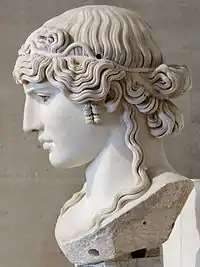Antinous Mondragone
The Antinous Mondragone is a 0.95 m high marble example of the iconographic type of the deified Antinous, of c. 130 AD.[1] It can be identified as him from the striated eyebrows, full lips, sombre expression and the head's twist down and to the right (reminiscent of that of the Lemnian Athena), whilst its smooth skin and elaborate, centre-parted hair mirror those of Hellenistic images of Dionysus and Apollo.
| Antinous Mondragone | |
|---|---|
 | |
| Year | c. 130 AD. |
| Type | White marble |
| Dimensions | 95 cm (37 in) |
| Location | Louvre, Paris |
It formed part of a colossal acrolithic cult statue for the worship of Antinous as a god. Thirty-one holes in three different sizes have been drilled for the attachment of a head-dress (possibly a lotus flower or uraeus) in metal; the sculpture has also lost eyes in metal, ivory or coloured stone.
It is said to have been found at Frascati between 1713 and 1729 - it was certainly displayed as part of the Borghese collection at their Villa Mondragone there. Winckelmann made it better known by praising it in his History of Ancient Art, calling it "the glory and crown of art in this age as well as in others" and "so immaculate that it appears to have come fresh out of the hands of the artist".[2] This was since, though Roman in date, it echoed the 5th century BC Greek style which Winckelmann preferred over Roman art.[3]
In 1807, it was bought with a large part of the Borghese collections for Napoleon. Sometime after this, a brown layer of wax was added to give an opaque finish, along with plaster round the base of the neck to make the statue look more complete - these were both removed in recent cleaning. It is now held at the Louvre Museum, though it toured to the Henry Moore Institute, Leeds in 2006 for the exhibition "Antinous: The Face of the Antique",[4] and returned to the United Kingdom for the British Museum's exhibition "Hadrian: Empire and Conflict" in 2008.
Notes
- Antinous, the lover of Emperor Hadrian, drowned in the Nile that year.
- In the posthumous publication of Winckelmann's history translated into Italian with copious notes by Carlo Fea, Storia delle arti del disegno presso gli antichi Rome, 1783-84, it was described in vol. II, p 386, noted by Francis Haskell and Nicholas Penny, Taste and the Antique: The Lure of Classical Sculpture 1500-1900 (Yale University Press) 1981, p. 101.
- In contrast to Winckelmann's enthusiasm for it, John Addington Symonds criticised the head in 1879 for its "vacancy and lifelessness".
- Exhibition page Archived 2007-01-06 at the Wayback Machine
External links
| Wikimedia Commons has media related to Mondragone Antinous. |
- (in French) Louvre database entry
- (in English) Photo repertory of Antinous types, for comparison
- Vout, "Antinous: Face of the Antique" (exhibition catalogue, 2006), p. 80-81.